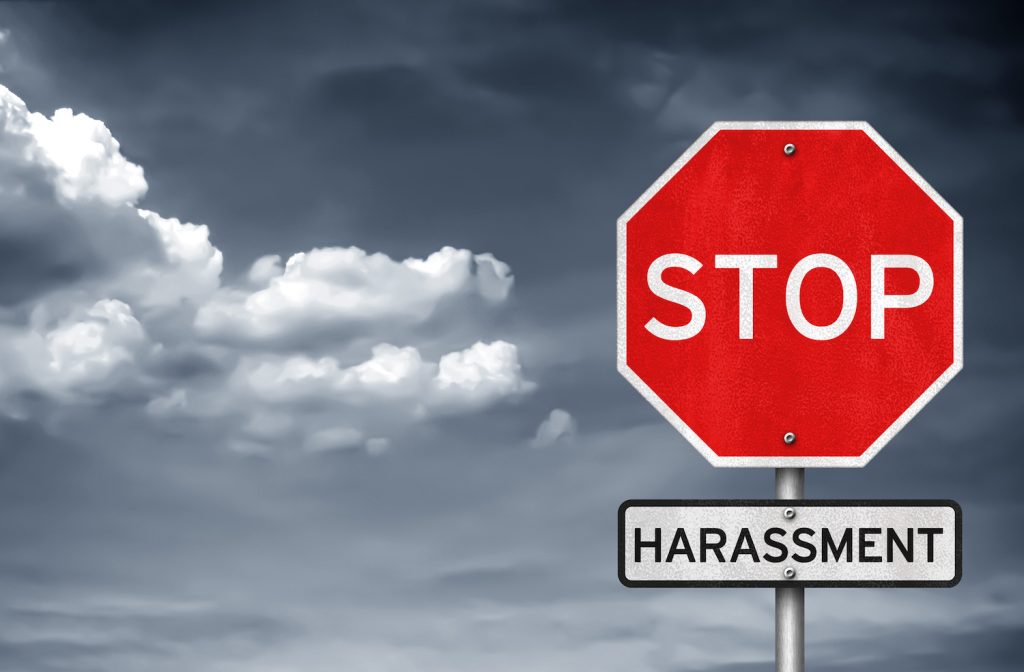In a nutshell: Any kind of harassment can cost you customers, employees and money. Here’s what small businesses need to know — and do.
There are many different kinds of workplace harassment, but they all have one thing in common — they ultimately will make a negative impact on your business. An organization that fails to address harassment issues likely will see demoralized employees and high turnover, which will affect productivity and profitability. Settlements can be massive and sap the bottom line. And, what’s more, if harassment becomes public, it can tarnish the reputations, not just of the victimizers but the organization as a whole. As harassment issues continue to come to the forefront, companies can no longer ignore the topic or try to sweep harassment under the rug.
While harassment at large organizations (including The Weinstein Company, Uber, and the United States Senate) makes headline news, it’s foolish to think that harassment isn’t an issue for smaller employers — including your company.
This article will help you explore the issues related to harassment and detail some steps you might take to reduce risk and exposure. We’re quick to admit, however, that our background and expertise is in the world of business, not law and human resources. That means you’ll probably want to do additional research and consult with a legal or HR professional before making any significant changes to your business policies, procedures or structure.
Sexual Harassment: What is the Law?
Sexual harassment is addressed in Title VII of the Civil Rights Act of 1964 (which is also the act that prohibits discrimination based on race, color, religion, national origin and sex in hiring and promotion). The U.S. Equal Employment Opportunity Commission (EEOC) says Title VII encompasses a wide number of circumstances, situations and actions. Here is the description offered by the EEOC:
“Unwelcome sexual advances, requests for sexual favors and other verbal or physical conduct of a sexual nature constitute sexual harassment when this conduct explicitly or implicitly affects an individual’s employment, unreasonably interferes with an individual’s work performance, or creates an intimidating, hostile or offensive work environment.”
Here are some myths to dispel:
Myth: Women can’t harass men.
Truth: Accusers and harassers can be either men and women. And, yes, the harasser and the accuser can be the same sex.
Myth: It’s only harassment if it’s between a boss and a subordinate.
Truth: Harassment is about the environment created, not about the organizational chart. Harassers can even be people from outside your company, such as an agent of a third-party vendor.
Myth: Only the person being directly harassed can make an accusation.
Truth: Anyone who is affected by offensive conduct can make an accusation.
Are Consensual Relationships Considered Harassment?
Title VII only applies to sexual conduct that is unwelcome. It doesn’t prohibit consensual relationships. And these relationships certainly do happen! Business Insider reports that more than half of American professionals have had a workplace romance, and 16 percent of those people met their spouse or partner at work.
However, office relationships can be problematic, especially when one of the participants manages the other person. To handle these situations, an employer can create and enforce reasonable rules for relationships. The Society for Human Resource Management has created a template employment dating policy for businesses of all sizes.
Other Forms of Harassment
Sexual harassment is one of many kinds of harassment experienced in the workplace. The Workplace Fairness Organization defines racial harassment as racially based unwelcome behavior that creates a work environment “that a person would consider intimidating, hostile or abusive.”
The EEOC says that harassment against lesbian, gay, bisexual and transgender (LGBT) employees is forbidden under Title VII, although that legal stance has been challenged by the U.S. Department of Justice. The status of LGBT employee protection varies from state to state, and even city to city. In 28 states, it is still legal for companies to fire an employee solely for being gay or transgender, according to Fast Company.
Combating Harassment
Large organizations have dedicated human resources functions and legal teams to handle the issue of harassment. What can you do if you’re a startup or small company?
Here are three suggestions. We recommend we discuss your strategy with a trusted legal or HR advisor before taking any significant action.
First, set the right tone at the top of the company. Leadership should be demonstrating the kinds of behavior they expect from the rest of the company. Make respect, diversity and inclusion part of your company’s DNA, and reinforce that message at every opportunity. And make sure that all employees know that they will be respected, and action will be taken, if they go to management with a concern.
Second, embrace diversity. Variety, a publication that covers the entertainment industry, says that having more voices represented in the workforce is “the single biggest way to clear the climate of fear and intimidation that so often prevents victims from coming forward with harassment claims.” Here at BAI, we’ve published some ideas for improving diversity at small businesses.
Third, consider training. Formalized anti-harassment training can do more than just explain the rules. Done properly, it can also set expectations for employee behavior and help people understand others’ perspectives. There are many options for in-person and online training.
Our lawyers say: The information provided in this blog is intended for your general knowledge and informational purposes only and is not a substitute for professional legal advice for your specific circumstance. You should not use this information with regard to your legal situation without consulting with your attorney.






